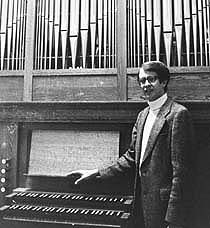Lee Garrett

Garrett not only has performed on some of the best organs in the world, he has advised countless churches on organ design and architecture.
“A wonderful organ is seen as well as heard,” Garrett emphasizes. “Its power to evoke mysticism and awe depends on its architectural beauty as well as its tonal character.”
Because each organ is specifically designed for a particular room, each instrument becomes the creation of planner and architect as well as builder and installer, he explains, pulling out a copy of Bernard Sonnaillon’s The King of Instruments. Of the 300 significant organs depicted in the book, only a handful are in the United States. One is at the U.S. Air Force Academy in Colorado Springs, Colorado, where Garrett performed at the beginning of his career. Another is in Agnes Flanagan Chapel at Lewis & Clark College, where he ends his formal career.
“Suspended from the ceiling, it’s an instrument of unusual visual character,” he says, “and it continues to attract world attention.”
Garrett remembers how the College’s Casavant organ, installed in 1972, still smelled of fresh wood and new metal when he first heard its gentle tone 29 years ago. Few days have passed since then when he hasn’t been in the organ loft practicing for a concert, playing for a church service or wedding, or giving lessons to students—many of whom went on to national competitions.
It’s one of builder Lawrence Phelps’ best designs, Garrett says, lauding architect Paul Thiry for his sensitive design of the chapel and thanking Agnes Flanagan for funding the organ and endowing its discretionary fund. Flanagan, a life trustee, died in 1990.
But the organ is just one of Garrett’s passions. His other passion is teaching a variety of courses, including music theory and history. “I try to help students discover what makes music grab them here,” he says, patting his heart.
“Last spring, I had a particularly rich experience leading some of the brightest students I’ve ever had on a study program in London,” he says. “A highlight was hearing a concert Agnes Flanagan would have loved. It included a piece by Maurice Duruflé—one of many world-renowned musicians who have performed on Lewis & Clark’s organ.”
To maintain the organ Flanagan funded and Duruflé played—now worth $1.5 million—Garrett will serve as curator of the organ. And he’ll continue to enrich the campus as College organist. Look forward to hearing the debut of a piece by Forrest Pierce, assistant professor of music, composed especially for Garrett and “the king of instruments.”
—by Jean Kempe-Ware
More L&C Magazine Stories
Lewis & Clark Magazine is located in McAfee on the Undergraduate Campus.
MSC: 19
email magazine@lclark.edu
voice 503-768-7970
fax 503-768-7969
The L&C Magazine staff welcomes letters and emails from readers about topics covered in the magazine. Correspondence must include your name and location and may be edited.
Lewis & Clark Magazine
Lewis & Clark
615 S. Palatine Hill Road MSC 19
Portland OR 97219

